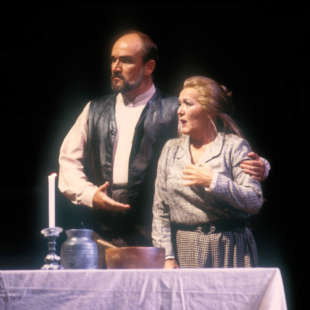Speight’s Wagner Memories: 87 RING

Gabor Andrasy (Hunding) and Leonie Rysanek (Sieglinde) in Wagner’s Die Walküre, 1987 © Chris Bennion
Das Rheingold passed without incident as did Die Walküre. The big event in the latter was in casting. I had asked the greatest Sieglinde of the era to come to Seattle to sing the role here. I didn’t know if Leonie Rysanek would participate, but I hoped that I might be able to convince her to do so on the basis of our long friendship. All I had to do, it turned out, was to show her three minutes of a video with the flying horses. I can still hear that well-loved throaty voice with the light accent of her native Vienna say, “Elu (her husband, Elu Gausmann), I have always wanted flying horses all my life. I will do this Ring. I can’t wait.” She proved to be, as most great artists are, an assiduous rehearser, never tiring, and very excited over Rochaix’s concept of Sieglinde. One more Rysanek story: on her first day she walked in the rehearsal room, looked at her Siegmund, Barry Busse, and her Hunding, Gabor Andrasy. She didn’t know either singer, and she looked at me and said, “You expect me to leave Sean Connery for him?” It certainly broke the ice.
Andrasy did and still does look very much like Connery. He was a major addition to the Ring that year. I had heard him in an audition in Munich and asked him to sing Hunding and Hagen. Thus began his American career. This Romanian bass has sung major roles in twenty-four productions at Seattle Opera in the ensuing 15 years, and he has developed a major American career. He has also married an American and became an American citizen, a resident of Florida.
That Ring saw the American debut of Toni Kraemer, a major European heldentenor, as Siegfried, a role he went on to perform at the Metropolitan. Julian Patrick continued in his remarkable performances as Alberich, a true singing approach to a role that is often barked. Most important of all, Hermann Michael, who had made his American debut at Seattle Opera conducting Tannhäuser in 1984, led his first Ring cycle, the first of eight he would conduct at Seattle Opera. The gentle and sensitive maestro, now the music director of the Arizona Symphony, led the Ring with great insight and a minimum of ego.
The two big changes in this Ring were the dragon and the final scene of Götterdämmerung. For this cycle, Fafner the dragon was a seven or eight foot tall creature with a scaly body and a double-sided head, with each face like that of the giant Fafner. There was an actor inside of the costume; the creature moved on his hind legs and fought Siegfried in a real battle. He was accepted by the audience then and, later, in 1991, but never loved.
The Immolation Scene, however, was a huge success. In Das Rheingold, the gods had moved to Valhalla from a high structure, a high structure with a lot of ladders on it, and the top platform approached only by a ladder. In the third act of Götterdämmerung, we saw the base of the tower, now destroyed, existing in the forest. Siegfried’s body was placed upon the base (now made of fire-retardant steel) and the whole scene was played around the base of the tower. Brünnhilde sang all the first part of the Immolation to the left of the tower and in front of it. When she lit the pyre, she was given a torch by a chorister. She lit an unseen fuse in the center of the platform and continued to sing. The blaze began on the platform and, as she finished singing, became immense. She then walked up the steps to the platform and the flame exploded on each step behind her. The stretcher holding Siegfried’s body was pulled out without the audience’s seeing it, and Brünnhilde seemed to run into the fire, exiting unseen from the rear of the platform. The fire burned for about three minutes full tilt, using 270,000 BTUs of propane per minute. It was a fire that lit the whole theater and blazed more than 20 feet in height. The heat could be felt in all the seats. When the Rhine was supposed to come in, the flames were extinguished as the blue material descended from the flies. In all eight performances over the next eight years, all the flames were out by the time the blue material reached the once hot platform, cooled quickly by CO2 steam. The Rhine Daughters leapt up on the platform and Flosshilde was seen peeking through the blue material, holding the now redeemed ring as the final music played.
This conclusion was an immense success with the audience. I was ecstatic; the audience was screaming; when Israel and Rochaix came out there were a few boos, overwhelmed by cheers. As I stood in the back of the house reveling in the moment for which we had worked so long and so hard, a man walked past me, wheeled around, and said, “You should be ashamed.” It was a mild remark, considering the letters I had received, but it completely took away the feeling of joy coursing through me. I will never forget that man; he taught me never to believe for even a moment that one can please everyone.